ARTICLES & GUIDES
Digital Communication: how to
develop an
effective strategy
in a nutshell
The complete guide on Digital Communication (inclusive of tools, metrics and KPIs): learn how much you can make in different countries, channels, tools, metrics, KPIs, and how to effectively manage crisis communication.


Don’t have time to read it all?
Here’s a brief summary of the key points in this guide.
What are the benefits of digital communication?
Regardless of the type of good or service offered, a business today cannot think to survive without digital communication: that would be an anachronistic attitude. Digital communication means:
- • Radical decrease in cost and time
- • Maximum level of interactivity
- • Targeted customization of messages
- • No distance between sender and receiver
[DIVE IN]
How do I implement an effective digital communication strategy?
Good digital communication should mainly aspire to elicit interaction with and among users. That is its ultimate goal and its main distinguishing feature. Interaction, however, does not arise on its own — it needs a push. Luckily, there is no shortage of tools for digital communication. Here you can find some of them:
- • Corporate website
- • Social networks
- • Community Engagement
- • Digital PR
- • Media Relations
- • Reputation Management
- • Corporate Social Responsibility (CSR)
[DIVE IN]
What KPIs should I monitor to evaluate the progress of my strategy?
The importance of Key Performance Indicators lies in their ability to inform a manager, a department, or an entire company about which specific parts of the adopted strategy are working and which are not. There are plenty of KPIs which vary depending on the developments being monitored (and the company itself). These are the generally most widely used KPIs:
- • Engagement rate
- • Conversion rate
- • Impressions
- • Customer acquisition cost
- • Cost Per Click (CPC)
- • Keyword Rankings
- • Customer Lifetime Value
- • Average Time on Page
- • Bounce rate
- • ROI (Return on Investment)
[DIVE IN]
How can communication be used to manage crisis situations?
If a corporate crisis arises, the number one rule is to take control of it. Only professional communication can restore a state of safety in people affected and in the company itself. Here is how:
- • Anticipating
- • Recognizing the crisis
- • Measuring its impact
- • Planning
- • Addressing the right people
- • Building stable trusting relationships with the media
- • Taking responsibility
- • Not remaining silent
[DIVE IN]
LEARN TO RIDE
Ready to surf the digital wave and become a leader in your industry? Join Execute.Club, where executives and managers like you can access resources, connect with peers, and get the no-nonsense help you need to succeed in the digital era.
Enter the ClubINTRODUCTION
Presenting: Digital Communication
History teaches us that communication is a form of transmission that has undergone epochal changes at increasingly shorter intervals of time. The earliest forms of communication that resulted in spoken language date back about a hundred thousand years.
But the evolution of society brought with it a wealth of information that could no longer be sustained by collective memory alone: a functional tool was needed for the preservation and reuse of all the knowledge accumulated year after year.
Written means of communication were born, which over the centuries went from cave paintings to ideograms, from hieroglyphs to the alphabet, from printing to the optical telegraph. Then, ever faster, telephone, radio, television, cinema and finally computers, paving the way for the advent of today’s digital communication.
an overview
What is digital communication?
The latest frontier of communication embraces the digital world in its entirety. The development of technology is running at a hellish pace, and being able to keep up with the times is a sensational competitive advantage for a business in an era when everyone – consumers, stakeholders, and potential ones – wants to feel involved and at the center of attention.
Digital communication can thus be defined as all the activities of producing, processing, and disseminating multimedia content using digital technologies such as computers, tablets, smartphones, satellites, and whatnot. Be careful, though, not to confuse it with marketing. Communication, indeed, is based on a variety of actions that do not necessarily help to generate revenue. We’ll go deeper in a moment.
The importance of being digital
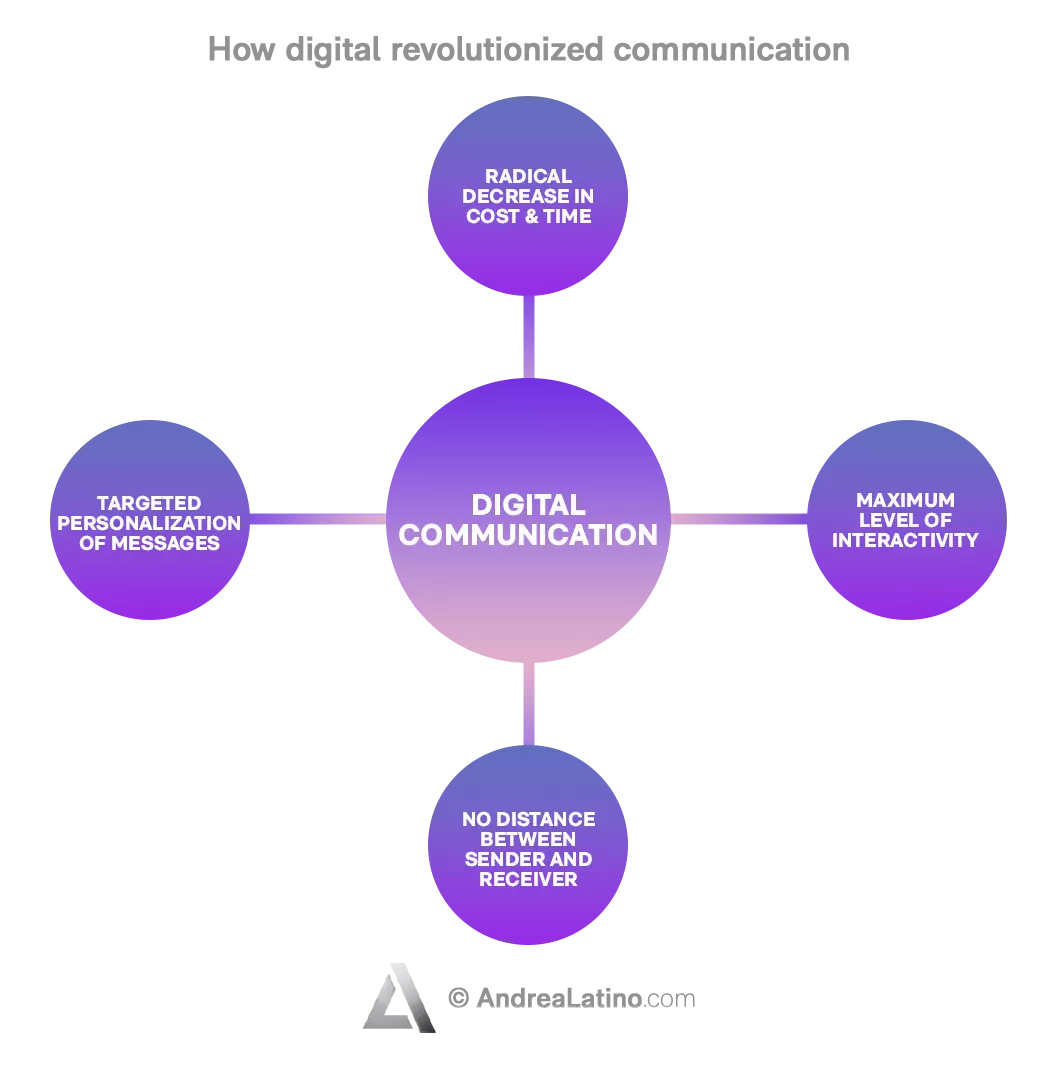
No company that aspires to expand its market can live without digital, because it ensures the only form of communication that allows targeted personalization of the message. It means identifying a precise target audience, studying its characteristics, and understanding its needs in order to tailor a customized contact that conveys a unique, effective, and engaging experience to the recipients. This is also made possible by the very nature of the IT environment, in which the relationship is networked: the exchange of information goes from one to many, and those many talk to each other, generating a maximum level of interactivity.
Regardless of the type of good or service offered, whether traditional or innovative, a business today cannot think to survive without digital communication: that would be an anachronistic attitude. By taking advantage of the possibilities offered by multimedia and the radical decrease in cost and time, the distance between sender and receiver is cancelled and public relations change. Marketing becomes conversational and relationships are conducted on the Web, within the reach of a click. A brand’s reputation, success and image come to be built on the basis of users’ digital behavior. Which can be a double-edged sword, of course, but good use of social media leads to content sharing, the release of reactions and comments, and, in general, the proliferation of online traffic.
Digital media, then, use digital signals to transmit information more quickly and efficiently between source and destination. They offer a body of opportunities that are impossible not to tap into, but you still need to proceed with caution. A good preliminary communication plan must understand which tools and channels are appropriate for the company’s purposes and how to combine them accordingly, without leaving anything out.
Tools, metrics and kpis
What are tools and activities of digital communication?
As a matter of fact, good digital communication should mainly aspire to elicit interaction with and among users. After all, that is its ultimate goal and its main distinguishing feature. It does not matter whether it is a simple “like”, the sharing of a post or its comment: what really matters is that all potential leads of a company contribute firsthand to the construction of a successful brand image, manifesting their own points of view or talking about their own life and consumption experiences.
Interaction, however, does not arise on its own – it needs a push. A company that decides to go digital finds itself with an important variety of tools through which to convey its messages. If we think about it, as customers we receive daily promotional offers via e-mail and we are registered in the filtering bubble that then returns theoretically interesting purchase suggestions to our social pages. But not only that, we often tend to forget traditional (or, perhaps, more archaic) digital channels such as radio and television. In short, there is no shortage of tools for digital communication. Let’s look at some of them together.
Corporate website
The website is the IT “home” of the company and, as such, it should be furnished in an aesthetically pleasing manner, with an intuitive and easy-to-use interface and an attractive graphic structure that is coherent between layout, colors, and content. To persuade visitors to stay there longer and more willingly, the site must be easily navigable and reflect the company’s vision.

It is advisable to enrich it through strategic Calls to Action, placed in the right places and in harmony with each other, not in excessive quantity. The site must aim to inform, entertain, and create engagement: therefore, it should contain external links that redirect to social media.

But in order for Internet users to find the exact address, the business site must enjoy good search engine rankings and appear among the first page results (considering that the average user usually does not dare to venture to the following pages). A useful strategy in this direction is the use of the most typed keywords.
Now all that remains is to integrate the online home with tools for monitoring and knowing your guests, such as Google Analytics, to track a number of metrics that we will discuss later and that help to understand the level of accessibility and effectiveness of the website.
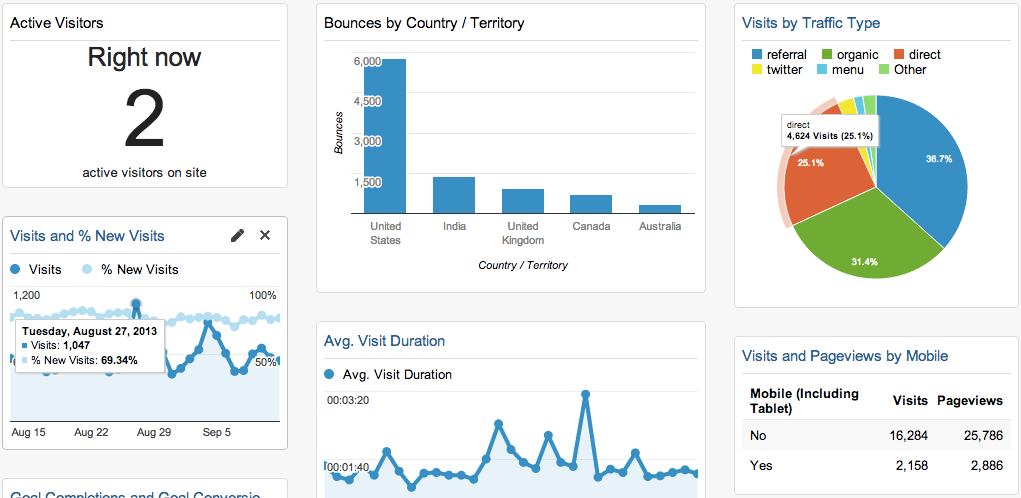
Social networks
Probably the true leaders of digital communication. They have revolutionized the concept of sociality and introduced the possibility of buying or selling products and services. And companies, rightfully, jumped headfirst into them to implement brand image and present them as loyalty and advocacy tools.
Moreover, each social network has its own peculiarities: Instagram and Pinterest, for example, will be the preferred channels for storytelling through images, not forgetting the value of hashtags. Hashtags are also prevalent on Twitter, which is great for sharing short messages (“tweets”), information and customer service. LinkedIn, then, is the undisputed leader among professional platforms, useful for publicizing one’s job ambitions or goals, especially in the B2B sphere. Facebook is the most heterogeneous social: it generates notoriety and consideration, is prone to customer care and is a huge marketplace.

Social networks lead to the formation of communities among users that help increase the perceived value of the page and, by extension, of the brand. But some golden rules must be respected: every social requires participation and transparency. It is necessary to take care of the content published, making sure that it is interesting, relevant, and original. Finally, above all, never open a channel unless you can manage, enrich, and update it regularly.
Community Engagement
Digital communities are groups of users who, in the same shared virtual space, unleash common interests, worldviews and values. A dense network of relationships aimed at satisfying diverse needs, both relational and commercial in nature. In fact, as much as the concept of community may be mistakenly linked only to “blogs” where hobbies, political ideas and religious beliefs are discussed, the phenomenon of web gathering also occurs around the sale of goods and services. This gives rise to communities of loyalists willing to become advocates and fight for the brand.

Digital PR
Online Public Relations are a digital tactic that embraces a set of activities designed to create participation and propose experiences: in short, they promote products, services and events related to a brand. The key players, in this case, are not mere IT tools, but journalists, bloggers and real-life influencers involved to increase impressions and boost your digital communication.
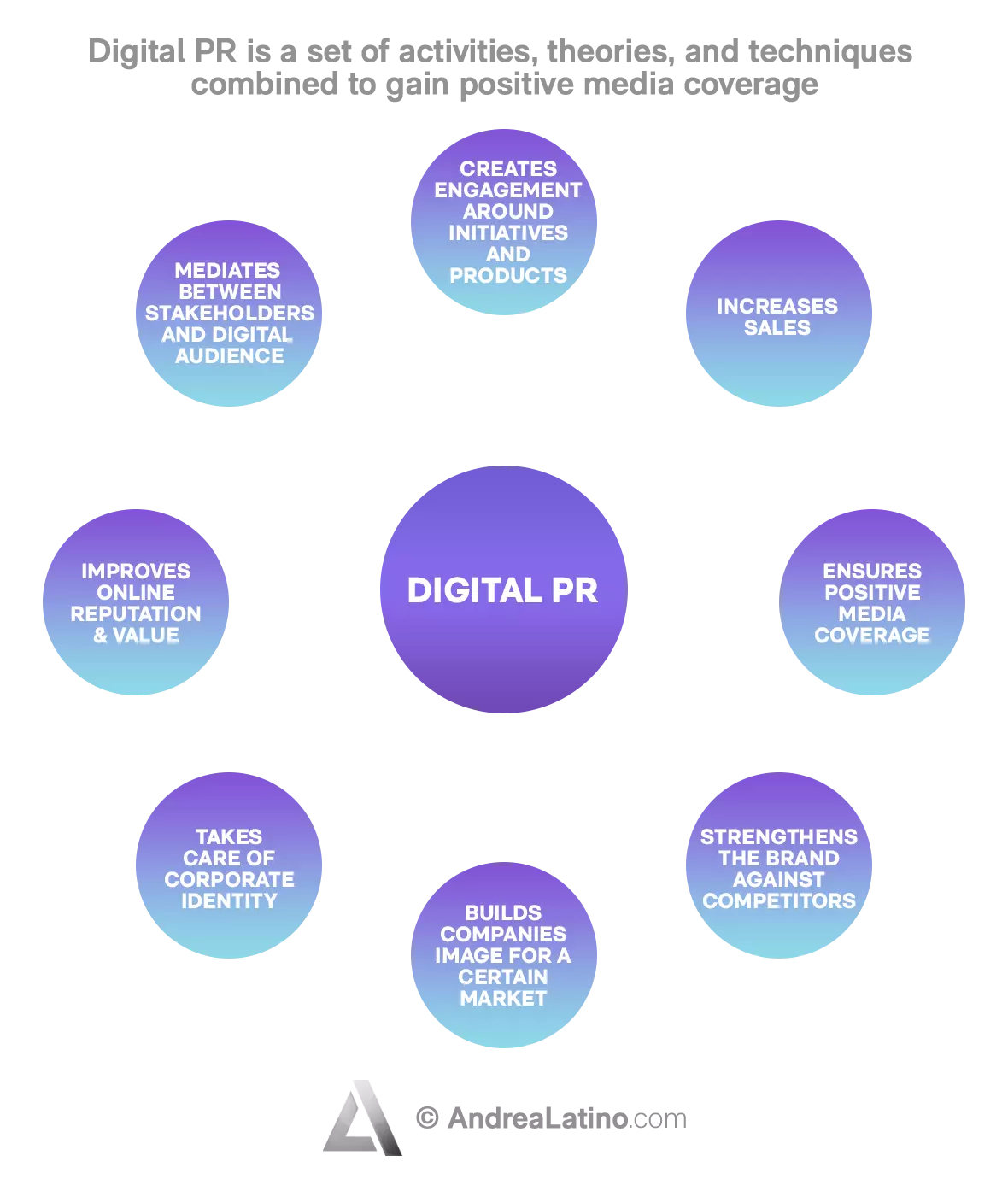
Media Relations
Among the activities of public relations and press offices, a very important role is played by so-called media relations. This is a system of press relations whose effectiveness depends on the relationship with newsrooms: the goal is to be known, recognized, and esteemed by the information managers in each media organization. It is a relationship of trust that arises from the interpersonal relationships that the PR expert builds and renews over time with communication actors.

Reputation Management
Every brand enjoys a certain reputation. This is no longer shaped through opinions expressed verbally, but mostly determined by information found online. Any activity on the web leaves traces that need to be monitored. Here, digital communication comes into play to constantly refine or enhance the company’s public image. The strategy adopted should be able to respond properly to customers, suppliers, and competitors. Proactivity is the right attitude to increase the chances of being appreciated.
Corporate Social Responsibility (CSR)
Companies often tend to assume a kind of voluntary responsibility towards their main social interlocutors: stakeholders. Digital communication falls among the practices adopted by companies in favor of a corporate policy that knows how to harmonize economic objectives with the social and environmental goals of the local area of reference, from a sustainability perspective.
A matter of scope: digital communication vs marketing
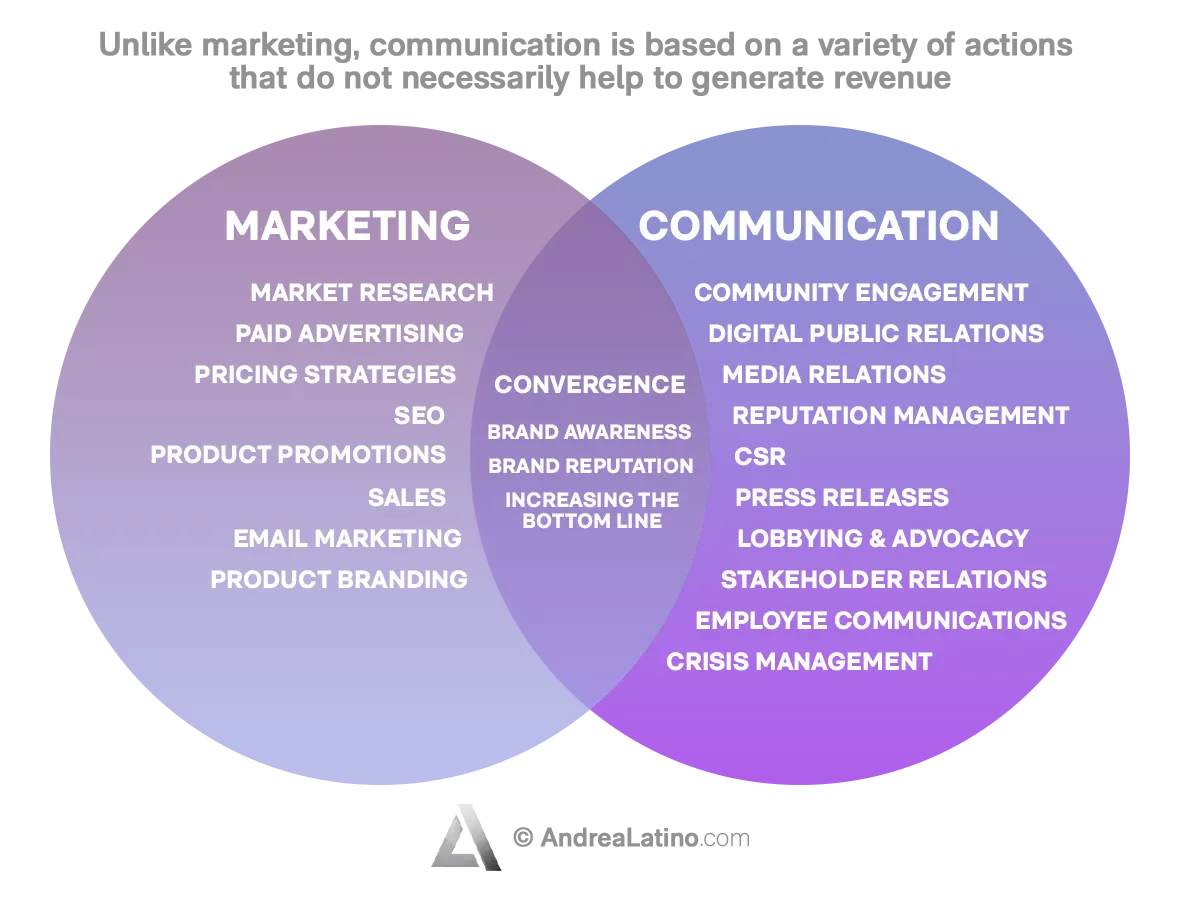
Briefly, as already mentioned, do not mix up proper communication activities and marketing assets. The main difference is the following:
• marketing concerns all those communications that aim at a transaction;
• institutional communication, press releases, lobbying, advocacy, and all other activities listed above are support functions that are not meant to generate income.
For example, posting content organically and continuously on LinkedIn is not marketing, but communication. Publishing paid content that addresses a campaign’s goals is marketing.
Digital communication: metrics and KPIs
Establishing the tools useful for successful digital communication is a crucial but not definitive step. You need to monitor the eventual success of your communication strategy or marketing campaign through metrics that are as accurate as possible. Qualitative and quantitative data that can be measured objectively, allowing senior executives to verify the degree of progress in set goals and improvements in business performance. We speak, in particular, of KPIs (Key Performance Indicators), the sincerest friends of a company that wants to know the real worth of the actions taken. But, again, prior skimming will be necessary.
Which KPIs are best to monitor?
The importance of Key Performance Indicators lies in their ability to inform a manager, a department, or an entire company about which specific parts of the adopted strategy are working and which are not. A typical case might be: you are generating revenue through your business but you don’t know where it is coming from or due to which strategy. As a result, you will not understand where to focus your attention and invest more time and money.
Therefore, the dynamics to be monitored should provide insights into how to improve your tactics and make more money from them. Otherwise, they are not worth monitoring – in other words, they do not represent an effective KPI. The best digital metrics to track will differ from company to company. Some will find it easier to identify them; others will risk confusion and will track worthless metrics, wasting valuable resources.
Careful monitoring of KPIs can, therefore, help a company understand whether the digital strategy put in place is correct and, consequently, optimize future operations. The choice of metrics to monitor depends on the growth objectives and the related strategies to achieve them. One of the main allies, in this sense, is the previously mentioned Google Analytics, free software that allows user profiling based on customized digital metrics. A platform integrated with the main web marketing tools and capable of measuring a key factor such as the ROI (Return on Investment) of all web marketing activities initiated.
Anyway, there are plenty of KPIs which vary depending on the developments being monitored. They can be related to sales, employee performance, Web site traffic or social page success. And to much more. Let’s take a look, then, at a collection of the generally most widely used Key Performance Indicators.
- • Engagement rate: the indicator that measures the engagement of a social page’s followers. A high rate indicates an engaged fan base in the brand’s initiatives. Warning: it does not necessarily mean having “lots of fans” but “lots of active, loyal fans” who comment and share posts. Better few but good.
- • Conversion rate: what percentage of visitors to a site will turn into leads and which leads will become customers.
- • Impressions: a fairly frequent metric that measures the number of times any online content (an image, video, web page) has been viewed by users.
- • Customer acquisition cost: the price of each conversion usually resulting from social media marketing activity. It can include advertising, mentions, and brand searches on browsers.
- • Cost Per Click (CPC): a key metric reserved for those who focus on paid advertising, as it shows the amount spent on each and every click performed by users and thus allows you to estimate how long your marketing budget will last.
- • Keyword Rankings: they show where your site ranks in terms of the most significant words and phrases from a search engine optimization (SEO) perspective.
- • Customer Lifetime Value: a measure of the average revenue a customer generates over the entire time course of their relationship with the company.
- • Average Time on Page: a view of the amount of time surfers actually spend viewing website content, so that improvements in landing pages or the content itself can be evaluated.
- • Bounce rate: the percentage of visitors who land on the site and immediately leave it. Ideally, the site’s landing pages should be made more seductive and engaging in order to convince users to stay longer.
- • ROI (Return on Investment): the real basis for the success of a business. It indicates the relationship between the investment and the economic return, to explain the profitable effectiveness of the invested capital.
let’s talk about money
How much do you make from digital communication?
The evolution of technology in relation to its importance in contemporary communication processes leads forward-looking companies to seek figures with experience or special skills in promoting products and services online.
Universities themselves, after all, are looking for ways to expand their degree programs to train students in digital communication issues as well, so as to cope with the pressing need of companies to hire qualified personnel in the field.

The big challenge for most businesses, especially small and medium-sized ones, is to bridge the digital gap. And the only strategy to win requires hiring resources with specialized skills, capable of bringing a breath of innovation not only in products and services, but more importantly in the ways in which these are communicated and brought to market.
Therefore, working digital in the contemporary age is never a bad idea: it complements (and probably outperforms) traditional sales strategies, and often becomes the only way to make yourself known. As a result, it is inevitable that professionals created by digital communication are highly sought after and also well paid.
Digital communication: how much do you make in different countries?

The web and digital communication professions sector turns out to be the tenth best compensated in Italy: the average gross salary is around 41,956 euros a year. Obviously, there are significant salary differences among the different levels of the industry: a manager can exceed 100,000 euros, a middle manager earns about half that, a clerk takes an average of 30,000 euros while the “normal worker” stops at 25,000 euros gross.
The fact that communication specialist is one of the best compensated jobs in Italy makes you wonder when compared with Germany. Here, the average gross salary for the same role is 70,125 euros or an equivalent hourly rate of 34€. An entry level communications specialist (1-3 years of experience) earns an average salary of 50,009 euros. On the other end, a senior level communications specialist (8+ years of experience) brings home an average salary of 86,678 euros.
The average Communications Specialist salary in the UK is £48,701 but the range is very narrow. In fact, it ranges from a minimum of £44,145 to a maximum of £57,253. Leaving Europe, the estimated total pay for a communications specialist in the Shanghai area is CN¥24,791 per month (about 3,345€).
How much do you earn in the U.S.?
Let’s consider the case of the United States, very often the cradle of technological innovation. But more importantly – as exemplified by the TV series Mad Men and its enigmatic main character Don Draper – home of the advertising industry as a captivating form of entertainment.
Compensation for a career in digital communications depends, again, on location, level of experience, skills, and other factors such as company size or location. In general, however, digital communications managers earn on average between $60,570 and $105,660.
On the more strictly creative side, in 2020 the U.S. Bureau of Labor Statistics (BLS) recorded that the average annual salary of a “simple” graphic designer reached $53,000. Writers and authors, on the other hand, went as high as 67 grand.
Do you have a Public Affairs & Comms challenge to tackle? Let’s face it. Together.
C-levels from these companies (AND MORE) relied on my expertise to overcome thEIR CHALLENGES IN THIS AREA. And you can, too.
Can I help you?Crisis Communication Management
When things go wrong: crisis communication management
Unfortunately, sooner or later, every company is likely to go through a particularly difficult period. And problems can arise from any direction: internally, as a result of bad decisions, or externally, caused by undue pressure.
A corporate crisis may vary in nature and magnitude, but no organization is immune. It can be economic, triggering a chain reaction. It can be a crisis of innovation, due to a refusal to update and keep up with the times. Or, again, it can be intrinsic and affect teamwork, undermining mutual esteem and help among colleagues. And it can be image-related, linked to a slip or miscommunication.
Anyway, crisis is a fleeting moment if it is handled seriously, planned and, most importantly, made with thoughtful decisions. After all, “crisis” in Latin and “krisis” in Greek mean precisely choice. Thus, to prevent some kind of difficulty from degenerating into an economic disaster, it will be essential to have effective, consistent, and well-organized crisis communication.
Downloadable files
- Crisis Management Checklist – Download now!
What is crisis communication?
By the term “crisis communication”, we mean the communication tools and strategies a company resorts to during a problematic situation to counter and mitigate its effects. In a broader sense, the definition would include elements and systems designed as much to anticipate crises as to respond in order to prevent the organization’s image from being negatively affected before it is too late.
Since we are in the age of new technologies, all information circulates at uncontrollable speed and requires timely action. Managing a crisis situation in an effective way therefore means preventing (risk management) and preparing to control the baleful event if it occurs (crisis management). As long as you are at a problematic juncture, the company cannot focus on its goals, because it would risk losing customer loyalty and a drop in turnover. It is at this point, then, that Crisis PR comes into play: that is, Public Relations work in the event of crises related to strikes, scandals, mass layoffs, product defects, management mistakes, and so on.
Crisis communication: what is Crisis PR?
In the public relations context, the main goal of crisis communication management is to avoid or minimize reputational damage, since crises threaten the survival of the entire organization. The task of public relations in such cases is rather “ungrateful”; they do not have to present the company in a good light or highlight its qualities, but rather to contact stakeholders, inform them about the ongoing problem, mitigate their fears and restore trust.
In short, crisis communication must be an integral part of a company’s communication policy, a very important management aspect that, however, is often underestimated. Social media and online news services take little time to ensure that nothing remains hidden: bad news spreads in an instant.
Only professional communication can restore a state of safety in people affected and in the company itself. Of course, a problem is far from being a crisis, but if it remains latent for too long it can trigger an emergency. Then you need to be prepared.
Crisis communication: understanding its scope and developments

To get off on the right foot, it is first important to know the causes and hypothesize the consequences of the crisis. Usually, it is a combination of external factors (e.g., changes in the market) and internal factors (e.g., errors in production or employee selection). However, a crisis rarely occurs without anyone intervening.
Although it is not just a matter of taking appropriate action: the pressure is extreme, the timing is tight, the mood is negative. An effective solution must be found quickly to improve the company’s image in the eyes of the media, the public and, most importantly, the stakeholders.
We could summarize crisis communication in two stages:
1) direct communication aiming to restore the credibility of the company, handled by PR;
2) indirect communication aspiring to limit the damage caused by the crisis.
But there are many developments. Schematizing, the ideal evolution of a crisis involves an initial gestation phase, during which the first issues appear. Then an acute crisis: the media begin to develop interest in the difficulties that have emerged, which must now be addressed head-on. But the company’s problems will soon affect the general public (chronic crisis), until another “scandal” catalyzes attention elsewhere. Eventually, the state of recovery (loss of interest) takes over.
How to handle a crisis situation online
If a corporate crisis arises, the number one rule is to take control of it. I mean, it is not that simple. Also complicating matters is the fact that serious difficulties always affect different parties, who will therefore need to be informed in different ways, content, and tone. However, the main goal remains not to lose your space to maneuver or, if you do, to regain it as quickly as possible.
We have already mentioned how professional crisis management makes it possible to minimize potential damage, communicate transparently and reliably, and defend the company’s reputation. All of this should start with prior monitoring that allows for timely action under pressure afterwards, while maintaining the sovereignty of information. Crisis, in fact, should be managed, not suffered! Let’s see how.
• Anticipating. The forward-looking manager is one who, even (and especially) in times of quiet and prosperity, considers possible future crises and implements preventive measures.
• Recognizing the crisis. In the event of an emergency, it would be best for customers and suppliers to learn about the problematic situation from the company itself. If someone else disseminates sensitive information, there is first of all the risk that it will be misleading and decontextualized, but the company itself may lose trust and sympathy. In addition to openness and honesty, speed is another decisive factor in crisis communication.
• Measuring its impact. Before speaking out, it would be ideal to gather as much information as possible about the current situation. In this regard, the use of monitoring tools becomes necessary.
• Planning. A good idea would be to assemble a team to coordinate the action, consisting of a management officer, a communications officer, experts, and spokespersons: each employee will have his or her own task. The compilation and publication frequency of information materials should also be determined in advance.
• Addressing the right people. To appear professional, credible, and coherent: clear communication reinforces trust in the company and quiets rumors. Approach and language have a strong impact on overall perception.
• Building stable trusting relationships with the media. The same media that threaten a company’s image must be involved in delivering an official message. Therefore, it is important to stay in touch with journalists and keep social profiles alive.
• Taking responsibility. Explaining in no uncertain terms and without distributing blame what happened, what was implemented to quickly resolve the situation, and what to prevent it from happening again.
• Not remaining silent. If the company does not provide satisfactory information or, even worse, does not intervene, third parties will find their own explanations. This will result in rumors that can sling mud at the organization in question and amplify its problems. Remaining silent is the wrong attitude during a crisis: if you do not try to shape the debate, the public will take care of it in its own way.
Remember, then, that the parties involved predominantly get their news from social networks. Therefore, the choice of communication channel is crucial, as is prior regulation of the online platforms used. Honest and open communication also applies to social media: constant availability and admission of crisis inspires trust among users and results in high credibility.
Crisis communication management: important tips and clarifications
Well, it should be clear by now that rapid and coordinated action is urgently needed. Late or disorganized crisis communication could have fatal consequences. But there are still a number of clarifications that might be helpful.
First, personal communication, which must be approved by the company’s management level, should not be forgotten. This is an ongoing communication also carried out by employees, who, for example, could start by providing truthful information about the crisis situation to their acquaintances.
A very effective tool for struggling entrepreneurs is actually e-marketing, which, thanks to the possibilities offered by newsletter programs, makes it possible to develop a very personal communication. But beware of pitfalls:
• First of all, never, and I mean never, use a crisis (whether limited to your business or of international volume) to conduct a marketing campaign. Convey facts, not advertising messages.
• Don’t send the same e-mail to your entire address book, but build targeted ones to get the highest possible engagement rate.
• Set the right tone, remaining objective and avoiding alarming tones. Adopt an attitude that makes crisis communication more professional, creates interest and averts panic.
In conclusion, an indispensable role during crisis communication is played by the spokesperson. Indeed, the very choice of spokesperson represents a “message” even before he or she speaks. For example, if the spokesperson is the CEO, the company can convey the idea that it is completely focused on the affair and strongly committed to coming to terms with it.
In general, however, in times of trouble, you should minimize the number of figures talking to the media. One, maximum two, with respective support covering. And the storytelling should be consistent with respect to all the target audiences you want to talk to. It would make sense, then, to think from a single narration and later decline the story by choosing tools, timing, and messaging that will achieve the communication objectives.
Post-crisis
Once the raised issue has been resolved, communication does not stop: lessons must be learned. In this way, the company will be able to take prompt action if the circumstance recurs. “Professional follow-up” helps to identify mistakes made and optimize performance in the future.
Also, it will be essential restoring the trust of your stakeholders, starting with recording and classifying what has been learned from the crisis and setting up strategic reputation management.
Crisis communication: a few examples
One of the most recognizable examples of crisis communication on a national and international scale concerns the management of information transmitted to citizens during the pandemic situation due to the spread of Coronavirus. It is actually a case of poor management of the problem on the communication level: the excessive presence of figures, in fact, making daily statements to the media generated a confusing and disorienting flow. As if the government, scientific committee, and civil defense were not enough, the voices of virologists, often disagreeing with each other, rumbled on.
Crisis communication management: the Volkswagen case
In 2015, a scandal broke out involving one of the world’s largest automakers, Volkswagen. The German manufacturer was installing a software on its vehicles (a total of about 9 million between Europe and the United States) that allowed them to successfully pass gas emission tests. In the month following the discovery, the brand suffered a drop in sales of about 5 percent. Crisis management began guiltily late, with the CEO at the time merely downplaying the facts. Very serious mistake: the news spread on the web.
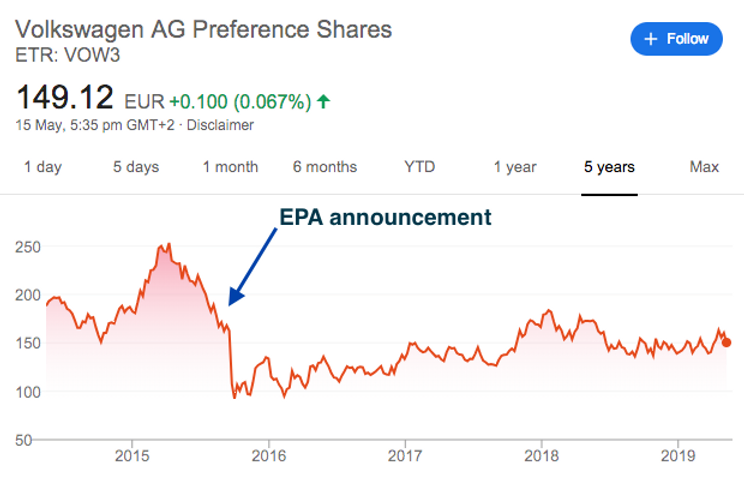
Volkswagen realized then that it needed to revise its strategy in communicating the crisis. The new CEO apologized through a video, shared on the website and social media. To promote transparency, the company later commissioned an external survey to catalog the affected vehicles, followed by an action plan to recall them and bring them into compliance. Finally, in the effort to make amends, the brand launched a campaign to invest in research and development of electric vehicles.
It’s true: Volkswagen waited too long before getting up to speed, yet it still remains well established in the global automotive market. But the event will continue to have strong financial consequences for the company, particularly on the stock market.
Good crisis communication: Nutella and palm oil
In late 2015, French senators introduced an amendment to hugely increase taxes on palm oil: an element that was targeted as harmful to health and partly responsible for deforestation. Unavoidably, Nutella – which contains 18 percent palm oil – was picked on along with its manufacturer, Ferrero.
But the recipe did not change. Ferrero explained to consumers the reason for using palm oil, which replaces the possible use of a substance that is instead carcinogenic. Nutella promised to make exclusive use of sustainable palm oil (although, despite this, there still remains some distrust of the vegetable oil). And lastly, Ferrero cleverly exploited social media to launch an advocacy campaign by targeting the product’s primary consumers: young people.
Nutella has not changed its production process, it has not abandoned palm oil, and most importantly, its sales have not weakened.

An important message for you
Hi there! I hope you found this article insightful.
Allow me to introduce myself. I’m Andrea Latino, the author of this article.
I have spent over a decade earning the trust of world-class multinationals, institutions, and startups for their digital and innovation initiatives.
Are you curious about my story and how I could help you?
See how I can help youStay in wonderland
Let me show you how deep the rabbit hole goes.
Here are more Articles & Guides:

Articles & Guides
Digital Communication: how to develop an effective one
March 15, 2023

Articles & Guides
Digital Political Communication: doing politics in the age of social media
March 15, 2023

Articles & Guides
Digital PR: public relations in the digital age
March 15, 2023

Articles & Guides
Digital Public Affairs: how to employ effective institutional communication
March 15, 2023

Articles & Guides
Digital Transformation for Human Resources: stages, tools and new skills
March 15, 2023

Articles & Guides
Editorial Plan: how to build a winning one
March 15, 2023

Articles & Guides
Employee Journey: how to track employee experience in 6 simple steps
March 15, 2023

Articles & Guides
Innovation Strategy & Innovation Management: best practice and examples
March 15, 2023

Articles & Guides
Digital Tools & Innovation Resources: the best sources for your innovation process
March 15, 2023
